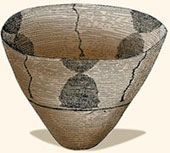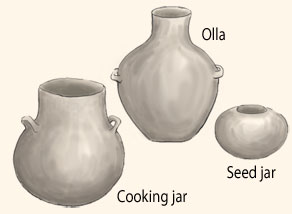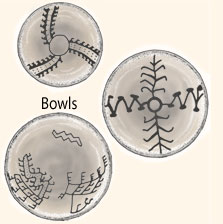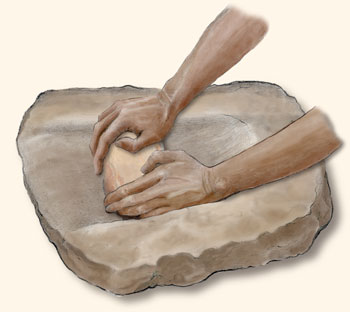Basketmaker Artifacts
|
How did people cook food in baskets?  People during the Basketmaker period made beautiful baskets out of plant fibers. Baskets were used for many purposes, including storing food, holding water, and cooking. |
|
 Other woven materials sometimes found at Basketmaker sites include aprons, bags, and sandals. Here are two very well preserved sandals from Basketmaker sites in Utah. |
|
Toward the end of the Basketmaker period, people began making pottery vessels. This was an important technological advance because it made it possible for people to cook food directly over a fire. People still used baskets but not as much as they had used them before. |
|

Basketmaker plain gray ware pottery.
Most Basketmaker pottery was gray and smooth. Archaeologists call it "plain gray ware." Most gray ware vessels were jars used for cooking and storing food. Large jars with small openings are called ollas (pronounced OY-yahs). Ollas were probably used to store water. |
|

Basketmaker white ware pottery. How did Pueblo people shape their pottery vessels?
A small amount of the pottery made during the Basketmaker period had simple black designs painted on a white or light gray background. Archaeologists call this kind of pottery "white ware." Most white ware vessels were bowls used for serving food. |
|
Ancient farmers used wooden digging sticks to plant their corn, beans, and squash. They would use the sharpened end of the stick to dig small holes. Then they would drop seeds into the holes and cover them with soil. This photograph shows a replica of an ancient digging stick. The sharpened end is to the right. 
|
|

People during the Basketmaker period began using a new style of mano and metate to grind their corn. Two-hand manos were large enough to be held in both hands. Trough (pronounced "trawf") metates had a rectangular depression, or trough, that was open on one end. This allowed the cornmeal to be pushed into a container as it was ground. |
|
At the beginning of the Basketmaker period, hunters still used spears and atlatls to hunt. But by the end of the period, these weapons were replaced by the bow and arrow. Bows and arrows were more accurate and easier to carry than spears and atlatls.  |
|
 DONATE TODAY
DONATE TODAY
